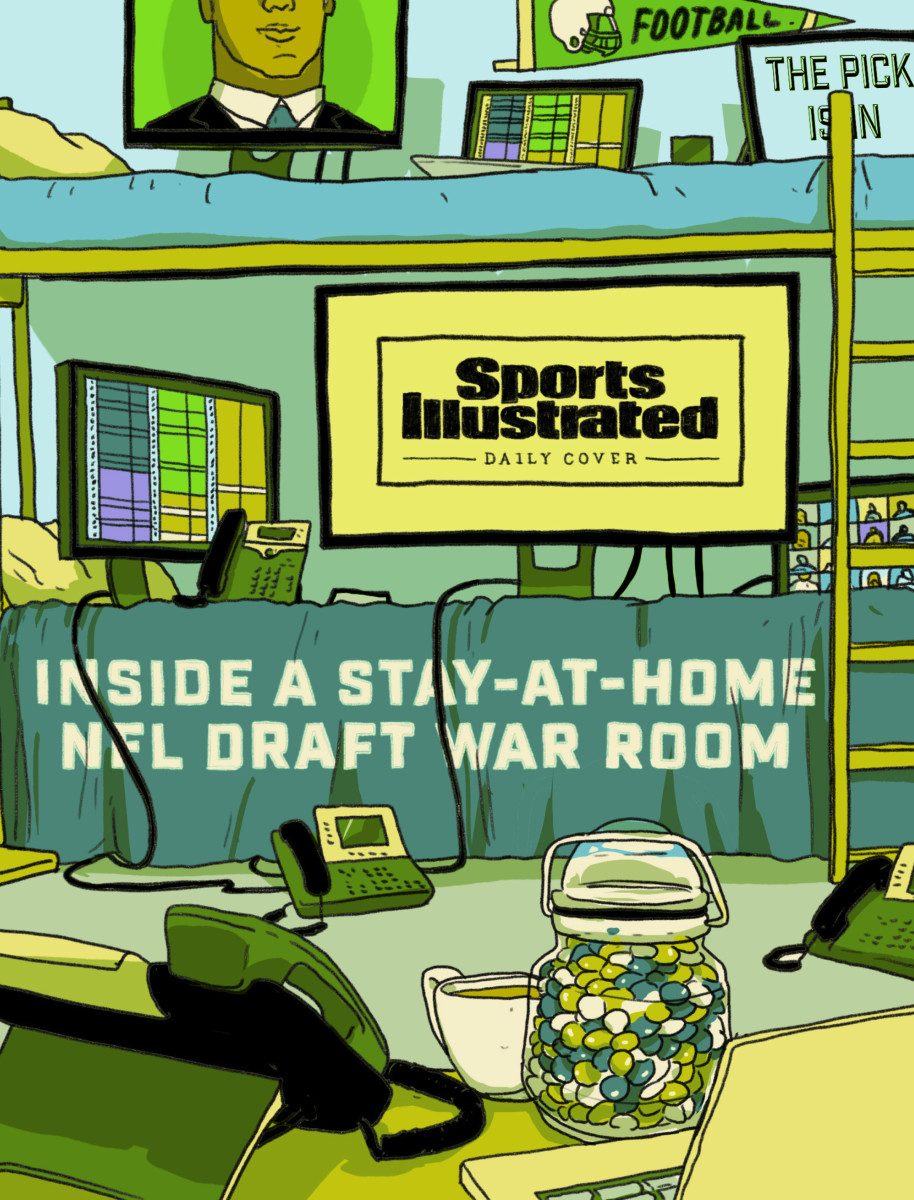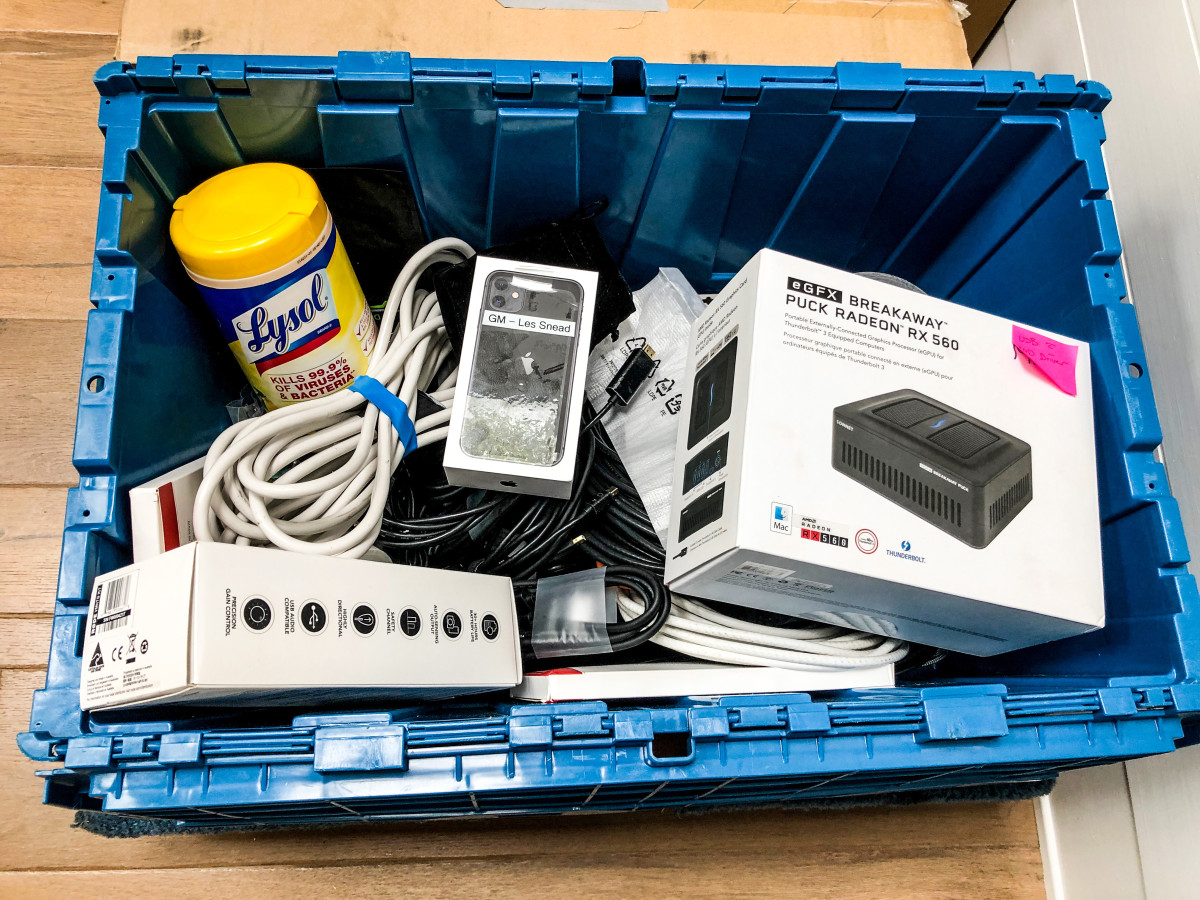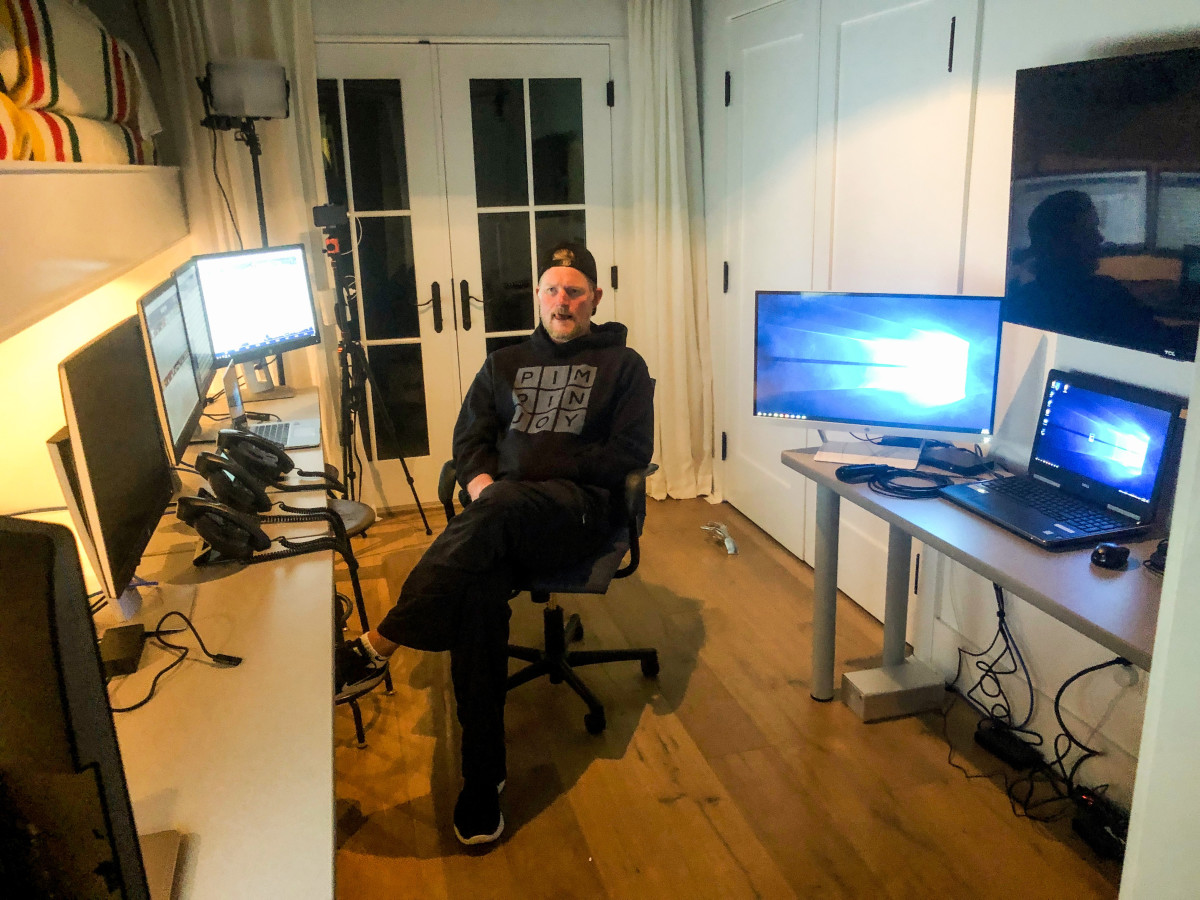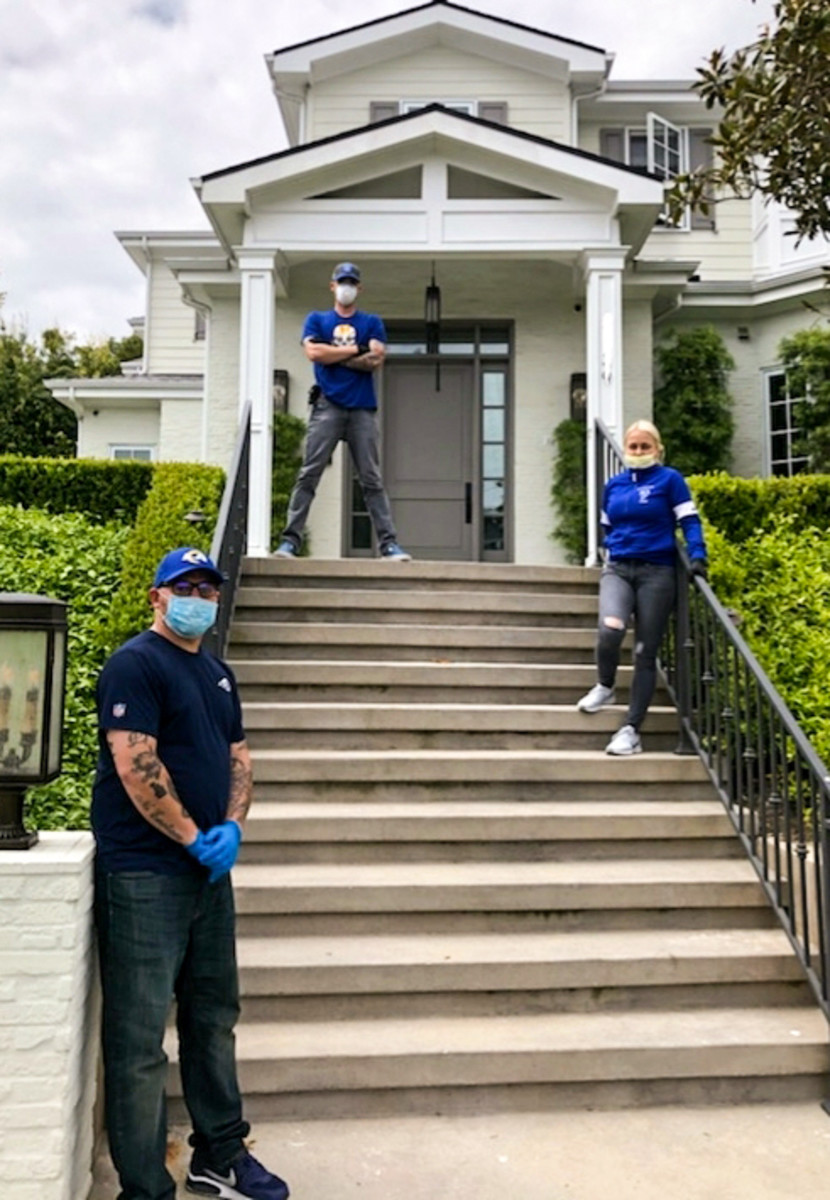Old Bunk Beds, Troublesome Kitchen Cabinets and Squawking Parrots: On the Front Line of the Virtual Draft
The IT team wears blue or white masks and latex gloves upon arrival at the Snead house last Saturday afternoon. As they begin the most unusual draft set up in NFL history, they pass underneath a framed picture hanging in the kitchen, the one that shows two hands locked in an embrace and says “hug more often.” Kara Snead gifted that print to her husband, Les, the Rams’ general manager and a notorious antihugger, even before COVID-19 turned the elbow bump into a fashionable greeting. “I had it right the whole time,” he deadpans.
The masks, the gloves, the physical contact jokes—all speak to the unusual circumstances all NFL teams must confront for the league’s annual draft to take place as scheduled on Thursday through Saturday. For the first time ever, GMs will be separated from their coaches and top lieutenants, and they will make their picks remotely, from their homes—in Snead’s case, a 2,400-square-foot ranch-style abode in Malibu.

As a middle schooler growing up in Alabama, Snead used to beg his mother, Pam, to let him skip school during the draft. He would pretend to be the general manager of his favorite team, the Rams, and he would make his “picks” near his childhood bedroom. This is kind of like that, except he’s now the actual Rams GM.
Starting tonight, Snead will draft from a converted guest room, bringing his career arc full circle. Seriously. Quick scouting report: 12 feet by 9 feet, four bunk beds affixed to the wall, letter jackets hanging in the closet and pool out back should Snead want to partake in a celebratory dip. This is where part of the Rams’ future will be decided, next to the bedroom of his 15-year-old son Tate Haver, who had to turn down the volume on his video games during recent evaluation meetings, and 10 feet from the master suite, where Snead himself nods off after long days of studying prospects.
The men in charge of that conversion, IT czar Jeff Graves and system administrator Boomer Williams, unload more than a dozen cardboard boxes and blue bins from the van parked near the basketball hoop in the driveway. Then they wheel the equipment into the house. “I don’t know if we’ve met,” Kara says to them. “I would shake your hand but …”
Snead assists the men in moving mattresses and clearing space for wires that will snake in every direction, along with setting in place enough screens to replicate a NASA control room. In fact, Rams coach Sean McVay had undergone the same process a day earlier, and he told Snead afterward that he “could probably launch a rocket into orbit.”
During a lifetime in football, Snead has spent almost every draft inside more typical war rooms, in Jacksonville, Atlanta, St. Louis and Los Angeles. He did travel to Canton, Ohio, in 1999, when the NFL summoned a representative from every team for the Browns’ expansion draft. A full 31 franchises sent someone from their pro personnel department; Al Davis dispatched a Raiderette. Another time, in 2012, Snead made a pick (Daryl Richardson, RB, Round 7) from under a table, due to a tornado warning a quarter-mile from the team’s facility in Missouri. But as far as unusual? Nothing will top this.
“You’re going to love it, Les,” Graves says, as the men begin their installation.

The GM supervises, arms crossed, asking questions, clad in his work-from-home best: Garth Brooks hat, sweats and Kara’s black reading glasses, the “coffee shop” style pair she bought on Amazon for $20. She has been joking that Les is the “Amazon version of Thomas Dimitroff,” his mentor, the impeccably dressed and perpetually bespectacled Falcons GM.
One item stands out as the men unpack the boxes: a tin of Rams-colored M&Ms. Apparently the NFL would prefer the sponsor’s candy appear in its television shots from the various compound set ups on draft night. “Which is ironic,” Kara says, “because I can’t remember the last time Les had a bite of sugar.”
Preparation for the install began weeks earlier, after COVID-19 effectively shut down the world of sports. The adjustments fell to Graves, the IT head with tattoo sleeves inked on both arms, and his tech team. They were more prepared than most, having handled the Rams’ move to Los Angeles three years ago, which happened in stages, with multiple facilities spread all over Southern California—training camp in one place, the business office in another, temporary headquarters somewhere else—plus in-season setups on the road. “The job is as full-time as parenting,” Graves says, and he’s not complaining. He loves the work, most of which goes unnoticed, his contributions, like with cybersecurity, vital but anonymous—until now.
Normally, Graves would spend the early part of the offseason engrossed in the projects that had been pushed back by the endless demands of another season. But once the pandemic hit, his team put all that work on hold to prepare for the draft. They started by building kits to bring to the four homes—for Snead; McVay; COO Kevin Demoff; and Tony Pastoors, vice president, football and business administration. Then they connected with the service providers near each home to firm up the local infrastructure. The Wi-Fi in Snead’s home, for instance, was unevenly distributed. They were able to fix that and have additional circuitry put in, for redundancy, should anything go wrong on draft night. They also set up a hub near the Snead’s kitchen island, inside a gray cabinet. But that hub overheated before the full install, and they had to remove the door entirely. Such is this strange new world.
As the process continues, Snead plays a voicemail he received that morning for the group. Using a private number, the caller identified himself as Ben from Monroe, La., and he lamented in colorful terms the pass interference no-call the Rams received to help them beat the Saints in the playoffs two years ago. “F--- you,” Ben from Monroe says in a way of signing off.
The men unpack the boxes like a tech version of Noah’s Ark. There are at least two of everything. Six monitors. Four phones. Three cells. Two routers. Backups for their backups. Wires on top of wires. One monitor for the Rams’ draft board, others for offensive and defensive picks, still others for video conferencing. Kara notes that this will be the first time the Sneads have installed a landline in this particular house.
This time most years, Snead would leave home to arrive at the office by 7 a.m. and not return until roughly 14 hours later. Now, he’s home endlessly, along with Kara and two of his three children, Tate and his stepsister, Cannon Snead, also 15. Tate is a long snapper in training and, during the install, he sails spirals into a net out back.
For all the technology going into that guest bedroom, Snead laughs at the rudimentary elements of this draft, too. The family members quarantined in nearby bedrooms as he and his staff discuss exotic blitz packages. The neighbor’s parrots who might squawk on live TV. The small red notebook with all his deepest thoughts inscribed neatly on the pages. “Notes on white paper,” Snead says, his head shaking. “Notepads.”

All of this is new. The Rams’ officials began working from home right after the NBA had postponed its season in mid-March. They were able to bring only one prospect to the facility, before the NFL shut down all visits. Their doctors couldn’t examine surgically repaired limbs. Their coaches couldn’t have prospects diagram on whiteboards—not in the same room, anyway. Snead spoke briefly to one prospect, Auburn defensive tackle Derrick Brown, while his son played against Brown online in Madden. He canceled another visit because the prospect was flying in from Seattle, near the original U.S. epicenter. But Snead believes that many of the changes teams experienced this year will be permanent. He wonders if franchises will incorporate the video conferencing technology into their operations, saving money by cutting down on the amount of time that scouts spend in Los Angeles, just for meetings.
As he says that, Graves interrupts. They need to move a mattress to stabilize a series of monitors next to the bunkbeds—the same mattress where Snead’s oldest son, Logan, had slept just a few months earlier. Logan is a college freshman, part of the football team at San Diego, but he moved to Alabama to help care for Pam, who was diagnosed with a form of leukemia during the Rams’ run to the Super Bowl LIII.
Needing an install break, Snead decamps to the kitchen, ready to tackle his primary at-home job: dishwasher. He wants to live up to his Danny Dishes nickname, which has been tough since his machine sputtered and he broke two glasses. His grade: C-.

The IT team completes the install at 8:22 p.m., after almost five hours of setting up. The room now holds more screens than a stock exchange, with cellphones on top of computer monitors on top of bunkbed boards, everything lined up neatly, ready for the draft. Even the M&M jar has been placed in the right spot.
Funny enough, Snead may not even watch the first 32 picks from there, as the Rams won’t make a selection, barring a trade up, until Round 2. During the three days, he’ll be allowed to have one IT guy and one security person in the room. Until then, the setup will continue. L.A. participated in an NFL mock draft on Monday, then held in-house mocks for the offensive side on Tuesday and the defensive side on Wednesday. Graves and his team will continue to begin their days at 5:30 in the morning, ending them well after the sun drops. They will continue to sweat security concerns. But there is no scenario, Graves says, in which their technology will fail. They are too ready, too backed up. Regardless, Snead jokes he’ll hop on his bike and ride to a hot zone if he needs to.
“The Command Center,” he says, gesturing around the room while wearing a black PIMPIN JOY sweatshirt.
“All done,” Graves says, knowing how wild the next week will be, how unprecedented all this is. He also knows what he’ll do to celebrate: begin installation for coaches to meet remotely with their players, back in familiar, more anonymous confines.
